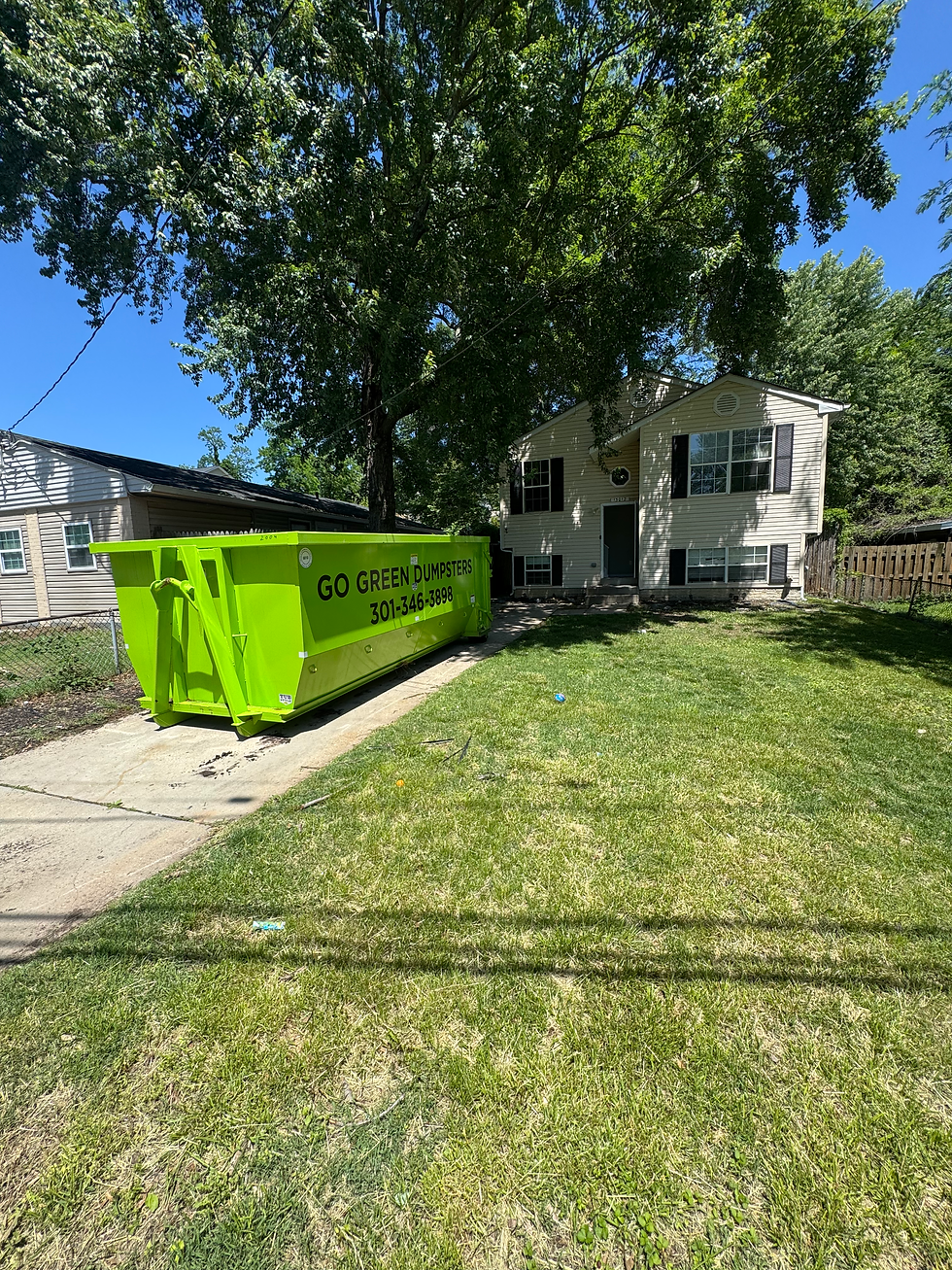How to Estimate Dumpster Needs for Home Additions
- Paulo Miller
.png/v1/fill/w_320,h_320/file.jpg)
- Oct 1
- 7 min read
Adding a room or extending a home creates a steady stream of debris and decisions about how to remove it. Estimating the right dumpster size and weight allowance up front saves money, keeps the site safe, and prevents delays from rejected loads or overweight charges. This guide walks homeowners and contractors across Maryland and DC through practical steps to calculate volume and weight, account for permits and placement, and choose a cost-effective rental plan.
Assess the project scope

Identify the work phases and debris types
Start by listing every phase of the addition: demo, framing, mechanical rough-in, insulation, drywall, and finish work. Each phase produces different types and amounts of waste—demo produces bulky, heavy pieces while finish work tends to generate lighter packing and trim. Use that list to plan dumpster needs by phase, not just by the total project.
Estimate the cubic yards you'll produce
Think in truckloads: many homeowners find it helpful to visualize how many pickup-truck loads the project will create. A 20-yard dumpster generally equals about 6–8 pickup loads, but the mix of materials changes that number. Count large items (cabinets, doors, bathtubs) and sheets (drywall, plywood) and convert those into rough cubic-yard estimates to avoid surprises.
Factor the timeline and phasing into your needs
If your addition is staged, demo first, then finishing, you may need multiple dumpsters or a swap schedule instead of a single long-term rental. Longer or staggered projects often benefit from planning for at least one mid-project pickup instead of overpaying for excess tonnage upfront. This is especially useful in busy Maryland counties where turnaround times and permit windows can affect scheduling.
Estimate by material type
Bulky vs. dense materials: why it matters
Materials fall into two practical categories: bulky (drywall, insulation, wood) and dense (brick, concrete, tile). Bulky materials fill space but are light; dense materials use up the weight allowance fast. For home additions that include masonry footings or lots of tile, plan by weight first.
Typical material quantities for common tasks
A full interior demo of one room often yields mostly bulky items—cabinet doors, sheetrock, trim—but a foundation or patio demo produces heavy rubble. For small additions, assume a mix: half the load by volume and half by weight, and adjust based on how much concrete, paver, or tile you expect to remove. A quick call to your hauler with the list of materials helps refine your estimate.
Use simple conversions to check your assumptions
A handful of rules of thumb helps: a cubic yard of broken concrete can weigh roughly 2,400–3,000 pounds; a cubic yard of mixed residential trash is far lighter. If you estimate several cubic yards of concrete, plan additional tonnage or a heavy-material container. Tools and online calculators can convert your counts of sheets and piles into cubic yards for a fast sanity check.
Site logistics and permits

Measure placement area and truck access
Measure the driveway or curb location where the dumpster will sit, and verify truck access and turning radius. Delivery trucks need room for safe placement and removal; narrow lanes, cul-de-sacs, and rowhouse streets common in Baltimore and older Maryland neighborhoods often require a smaller unit or curb placement with a permit.
Check permit requirements early
Many municipalities require permits for curbside placement or for dumpsters that block parking or lanes. Permit lead times vary, so apply early to avoid rescheduling. If you plan to place the dumpster on the street in Montgomery, Anne Arundel, or Prince George’s counties, check local rules and secure the required permit before your delivery date.
Protect surfaces and note property limitations
Older driveways, pavers, or soft ground can be damaged by heavy loads. Use plywood, driveway protection mats, or steel plates to distribute weight and reduce risk. Photograph the placement area before delivery; that helps document the site condition should any issues arise after pickup.
Choosing size and weight allowance
When a 20-yard is the right call
Choose a 20-yard dumpster for multi-room additions, whole-floor expansions, or jobs that generate lots of bulky finish materials plus moderate heavy waste. The 20-yard balance of volume and manageable footprint suits many suburban lot conditions in Maryland and DC.
Consider a 13-yard heavy-material unit for dense loads
If your addition requires removing slabs, patios, or brickwork, a heavy-material-rated 13-yard container can be cost-effective because it accepts dense debris without jumping to a much larger bin. Compare the included tonnage and potential overweight fees to see which option saves money.
Plan for overweight and add-on options
Ask about a flat-rate with higher included tonnage or the per-ton overage fee. For contractors, a higher-tonnage flat rate often beats surprise bills. If you expect phased heavy removals, consider booking a weight add-on for the demo phase only to keep costs predictable.
Cost considerations and local factors

Compare written quotes and ask about hidden charges
Request written quotes that list included rental days, included tonnage, taxes, and potential surcharges for long drives or restricted access. Vendors often advertise a simple flat price but exclude county disposal fees or permit costs. Comparing multiple written quotes helps you find the best value for your ZIP code. You can contact our team and we’ll review each line item to confirm what’s included and what could increase the final bill.
Account for seasonal and local demand
Spring and summer are busy for remodeling, so prices can tick up and delivery windows tighten. Historic or tight-access neighborhoods in Annapolis or parts of Baltimore may require extra coordination and labor, which increases cost. Booking early and confirming access details reduces the likelihood of rescheduling fees.
Factor in recycling and diversion options
Separate salvageable materials like cabinets, doors, and appliances for donation or resale; diverting these items reduces landfill volume and can lower your disposal bill. Ask your hauler if they partner with local recyclers, some haulers can route certain materials to recycling streams for a lower tipping fee.
Loading and site tips to reduce trips
Break down and compact to stretch capacity
Disassemble cabinetry, remove doors, and cut drywall and trim into manageable panels before loading. Compact soft materials and bundle cardboard tightly. These small actions frequently add significant usable space in the bin.
Load heavy items evenly and use gaps efficiently
Distribute dense pieces across the base and avoid creating single heavy pockets. Fill cavities with smaller trim, packaging, or insulation to prevent wasted airspace. Efficient packing reduces the risk of overweight zones that trigger surcharges.
Plan pick-ups around project milestones
Coordinate dumpster swaps or pickups at logical project milestones, after demo, after rough-in, and after finish work, so you avoid paying for unused rental days and keep the site functional. Staggered pickups work well for multi-week additions and help maintain a clean, safe workspace.
Estimating dumpster needs for a home addition combines material planning, site logistics, and clear communication with your hauler. Start by listing project phases and the types of debris each will produce, then convert sheets and piles into rough cubic-yard estimates while keeping a close eye on heavy items like concrete and tile. Measure and document placement areas, secure any municipal permits for curb placement well before delivery, and protect driveways with plywood or mats to avoid damage. Compare written quotes that spell out included tonnage, rental days, and county disposal fees so you can select the option that balances cost and capacity. Finally, stage materials, break down bulky pieces, and plan pickups to match project milestones; these practical steps reduce trips, limit overweight risk, and keep your addition on time and on budget.
Frequently Asked Question
How do I convert my material lists into cubic yards?
Count sheets (drywall, plywood) and estimate piles of loose debris; most calculators and vendor guides let you enter quantities and get cubic-yard estimates. If you prefer human help, call your hauler and describe the materials, they can give a quick conversion based on similar jobs in Maryland and DC.
Should I size for the heaviest phase or the largest volume?
Size the dumpster by the factor that will hit its limit first. If your job includes masonry, concrete, or compacted soil, weight usually controls and you should plan for tonnage. For finish-phase debris like trim, drywall, and packing, volume is often the limiting factor.
Do I need a permit to place a dumpster on the street?
Many municipalities and counties require a permit for curbside placement. Permit rules vary across Prince George’s, Anne Arundel, Montgomery, and Baltimore areas, so check early and secure any necessary approvals to avoid delivery delays or fines.
How can I avoid overweight fees?
Separate dense materials, break them into smaller pieces, and spread heavy items across the base of the dumpster. Disclose the expected material mix when you book so your hauler can recommend adequate tonnage or a heavy-material unit.
Is it better to get one big dumpster or schedule two smaller pickups?
That depends on project flow and site constraints. Single large dumpsters reduce administrative overhead but can be more expensive if you exceed weight limits. Multiple smaller drops or a planned swap often save money on long multi-phase additions and provide flexibility for tight-access sites.
What should I ask for in written quotes?
Make sure quotes include the rental period, included weight allowance, tipping and disposal fees, taxes, and any access or permit surcharges. Ask about re-delivery fees and extension rates so you understand the total potential cost.
Can I stage materials for separate pickups to save money?
Yes. Staging demolition debris, recyclables, and hazardous items separately lets you choose the most economical disposal path for each stream. Salvage and donation reduce landfill volume and sometimes lower tipping fees in competitive Maryland markets.
When should I plan the dumpster delivery during an addition?
Schedule delivery after you complete the demolition phase so you don’t waste rental days, or arrange a demo-focused drop that is swapped before the finish phase begins. Aligning delivery with project milestones reduces sitting days and helps keep the timeline efficient.



Comments